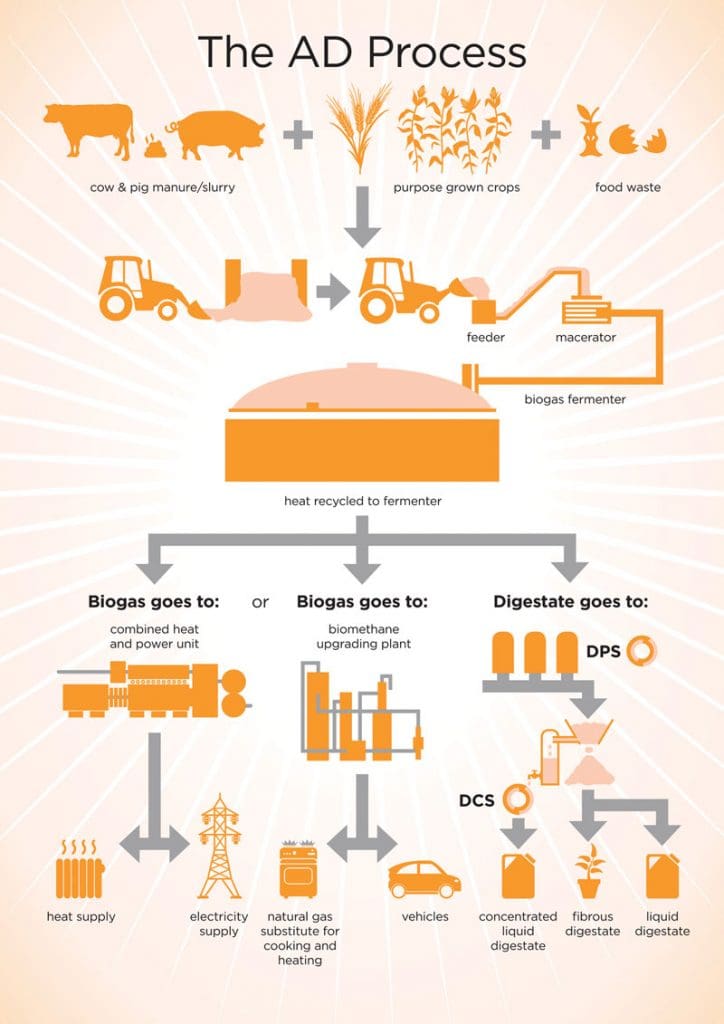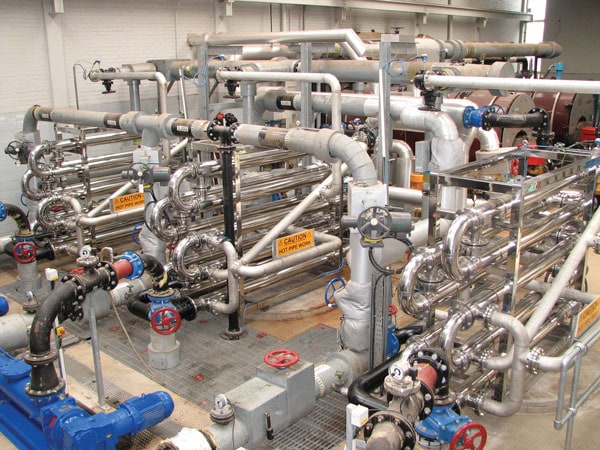With careful planning and a long-term approach, which considers the full life of an AD plant—not just initial purchase prices—the individual heat loads of each process within an AD operation can be greatly reduced by using recaptured heat, resulting in improvements in both efficiency and product quality.
Matt Hale
The use of anaerobic digestion (AD) has grown rapidly in the agricultural sector over recent years and there are somewhere between 260 and 550 biogas plants on U.S. farms.1 There are several reasons for this, including financial support from the Rural Energy for America Program (REAP) and the AgSTAR program. As well as providing a useful waste management tool, particularly for manure, AD produces many valuable and useful products, including biogas (which can then be turned into heat, electricity or biomethane gas) and digestate, which can be used as a nutrient-rich biofertilizer that is high in organic matter, or as a useful source of livestock bedding. However, many farm AD plants also produce incidental heat, which can be captured and used within the AD process or for other onsite operations.
Direct heat use, often generated by electricity, natural gas and liquefied petroleum (LP) gas is frequently associated with crop drying and livestock housing, with around 5 percent of agricultural energy use being used for crop drying.2 Making the most of waste heat has been an issue since the early 1970s3, and energy use is closely linked to agricultural business efficiency.2 By definition, those farms which have invested in anaerobic digestion are likely to already have a good awareness of energy issues, and so it makes sense for them to maximize the energy potential of their biogas production processes in their farming operations.
Sources of Heat
Surplus heat produced by biogas combustion in a combined heat and power (CHP) unit is the most common heat source within an AD plant. However, there are a number of other processes which result in residual, usable heat including:
- Digestate pre-heating
- Digester heating (especially in warmer climates when less heating is required)
- Electricity generation (e.g. via CHP)
- Digestate concentration, drying and separation
In some of the most advanced plants there may also be opportunity to capture heat from:
- Pasteurization (either before or after digestion)
- Biogas upgrading to biomethane (heat is required for the process, but up to 75 percent of it can be recaptured and reused)
For example, a minimum temperature of 158oF may be required for pasteurization. If using a boiler, this leaves 50° to 60oF of ‘left over’ heat, which has historically been wasted to the atmosphere. This heat could instead be put to good use elsewhere within the AD process. Equally, heat left over from concentrating digestate could be used for pasteurization.
What is a Heat Exchanger?
Heat exchangers take heat from one process or place and transfer it to another. In practice, they allow the heat from a liquid or gas to pass to another liquid or gas without the two having to mix together or come into direct contact. Common everyday examples include domestic radiators (which transfer heat from a boiler to a room) and car radiators (which take heat away from the engine).
Heat exchangers are used for numerous applications, including space heating, cooling, air conditioning, sewage treatment, food processing and in chemical industries. Increasingly, their potential role in the anaerobic digestion sector is being recognized, with more plants specifying their inclusion at the design stage or retrofitting them, either to improve overall process efficiency or to use heat that would otherwise be wasted.
Types of Heat Exchangers
There are different types of heat exchangers and it is important that the right type is selected for a particular application. Two of the most common types in use today are Plate Heat Exchangers and Tubular Heat Exchangers. However, within these broad categories there are many different models and refinements and it is important to understand what is being offered.
It is therefore advisable to consult a specialist who can explain the benefits of different types and perhaps offer different solutions. For example, viscous fluids such as digestate can quickly foul tubes and surfaces. For this reason, scraped surface heat exchangers are usually recommended, as they will constantly remove such fouling. However, another option is to use a tube design, which will minimize fouling in the first place. Corrugated tube heat exchangers are designed so that the constant swirling of the fluid in the tube prevents sediment and clogging.
Whichever system is proposed, it is important to compare running costs, including maintenance and cleaning, over the full life of the plant downtime caused by regular dismantling or cleaning as it can quickly eat into any capital savings made at the time of purchase.
Potential Uses for Heat in the AD Process
So, having identified a source of heat, what can be done with it? There are a number of options with the AD process itself, including: preheating feedstock, which can help to speed up the digestion process or improve gas production; pasteurizing, to ensure crop hygiene; and to improve the quality and reduce the volume of digestate. Using surplus heat in an Digestate Concentration System (DCS), for example, can reduce digestate volumes by around 60 percent, bringing significant savings in storage, transport and application to farmland, while retaining all the nutritional benefits.
In Europe, using waste heat to upgrade biogas to biomethane, for use as a transport fuel or for injection into the gas grid, is also becoming increasingly common. Depending on the exact technology used, as much as 75 percent of the heat used for biogas upgrading can then be recovered.
Other Uses for Heat
Captured heat can be used almost anywhere, provided that it is economically and practically feasible to transfer it. Even low temperature water can be used to reduce the amount of additional heating required, for example, by a boiler.
There are many uses of heat on farms, from space heating of greenhouses and polytunnels to drying crops or biomass fuels. Many livestock buildings require heat, particularly for pig and poultry production, and where farms have diversified to create office or business centers, there is often the scope to install district heating. It may even be possible to get support for high efficiency heating, ventilation and air conditioning (HVAC) systems under REAP, so talking to your local advisor or extension official may be worthwhile.
In other parts of the world, more unusual uses for heat have also been seen, such as aquaculture for fish production; further electricity generation through the use of Organic Rankine Cycle (ORC) technology and Kalina Cycle low temperature generation systems; and transporting heat in containers, which use latent heat storage technology. Although still relatively expensive, interest in using heat for cooling, through absorption, is also growing, particularly for sites where there is already an existing heat surplus.
An Endless Cycle?
It may be tempting to think that you can keep recapturing the heat used over and over again, but unfortunately, this is not possible. However, what is possible is to reuse some of the leftover heat to improve operational efficiency. Systems that do this, such a digestate pasteurizer, can often deliver efficiency savings of 40 percent or more compared to traditional pasteurizers without heat recovery.
With careful planning and a long-term approach, which considers the full life of an AD plant—not just initial purchase prices—the individual heat loads of each process within an AD operation can be greatly reduced by using recaptured heat, resulting in improvements in both efficiency and product quality.
As International Sales and Marketing Director for the HRS Group, Matt Hale is responsible for overseeing and developing the company’s strategies for business development and marketing. Headquartered in the UK, HRS Heat Exchangers Ltd operates at the forefront of thermal technology, offering innovative and effective heat transfer solutions worldwide, across a diverse range of industries. With more than 35 years of experience, they specialize in the design and manufacture of an extensive range of tubular, corrugated and scraped surface heat exchangers. All products comply with the ASME standard. HRS has a network of offices throughout the world: Spain, USA, Malaysia, Australia and India; with manufacturing plants in the UK, India and Spain. Matt has a proven background of more than 20 years within process and mechanical engineering and aims to provide effective heat transfer solutions to overcome industry challenges. With a focus on renewable energy, Matt works closely with the company’s global sales teams to achieve their goals. He can be reached at +44(0)1923 232 335 or e-mail [email protected].



